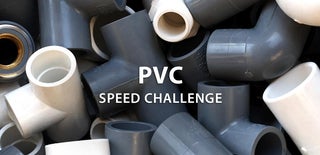Introduction: Hitch Cargo Carrier Bag PVC Frame
This a PVC frame for a hitch mounted cargo carrier bag. The cargo bags are great for putting your stuff in to during travel, keeping it all dry and clean, but most bags are just that, bags. This frame helps to make the bag more ridged and easier to load/unload and arrange your stuff.
This build is for the following a cargo bag that is 59x24x24
Supplies
Needed PVC:
- 5 - 10' 3/4" PVC pipes
- 8 - 3/4" PVC Side Outlet 90-Degree Socket Elbows
- 4 - 3/4" PVC Tees
Tools:
- Miter Saw
- Measuring Tape
Step 1: Measurements
- Determine the approximate internal size of you hitch cargo bag.
- Measure the length, depth, and height of the bag.
- Measure the size of your hitch carrier.
- Mine had a slightly smaller depth than the internal depth of my bag.
- The length of the Pieces will be determined by the following formulas
- Horizontal Pieces:
- ((Bag length) - (2 90-degree elbow lengths) - (1 Tee Length) + 2 inches) / 2
- Vertical Pieces:
- ((Bag height) - (2 90-degree elbow lengths) + 1 inch
- Depth (Top/Bottom) Pieces:
- ((Bag depth) - (2 90-degree elbow lengths) + 1 inch
Measurement Notes:
- All connectors have an insertion depth of 1/2 inch, that is the reason for adding inches back
- The bag depth may need to be substituted for the Hitch Carrier depth as it might be smaller than the bag depth
- There are 2 vertical pieces that go in the middle for support, they will be the same length as the pieces using the elbows
Step 2: Cut PVC
In the end, you will have:
- 4 - Top/bottom pieces
- 6 - Vertical pieces
- 8 - Horizontal pieces
Figure out the most efficient way to cut the sizes you need to get the most out of the 10ft pieces.
As I cut, I also tested the fit just to make sure before cutting all pieces.
Step 3: Assemble the PVC
- Note:
- I found it easier to assemble if I marked the depth pieces because they are only an inch shorter than the vertical pieces.
- You don't need to glue it together it is tight enough without glue. This will allow you to assemble and disassemble as needed.
Step 4: Fit in Bag
Place the assemble in bag, this should be snug but not too snug as to cause too much pressure on the bag.
Test the closure of the bag completely to make sure that it will properly close around the structure.
Step 5: Fit/Place on Carrier
Take the bag and assembly and verify that it fits in the hitch carrier. My first attempt found that the width of the carrier was slightly smaller than the bag and I had to cut down the sides one more time.
Step 6: Done
Load it up and have a good trip!!!

Participated in the
PVC Speed Challenge









